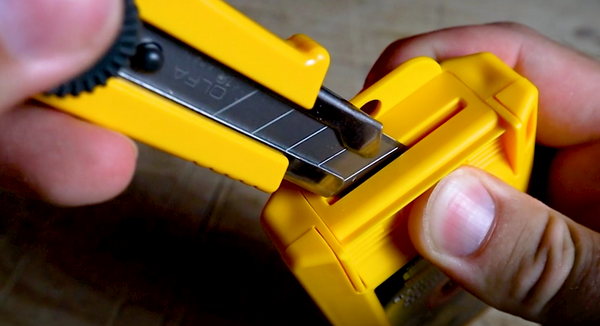
Blade Snapping 101
When your projects require perfect cuts and you find yourself frequently changing your utility knife blade, snap-off knives should be your go-to tool. Snapping a blade allows for an instant sharp edge the second dull segment of the blade is snapped. A dull blade is an unsafe blade because more force is required to make a cut with the worn-out blade and may lead to skips or injuries. Although snapping the blade may seem like an easy process, it’s important to know the steps involved to do it effectively and safely. And who could better teach us how than experienced carpenter Chris Milton (@modernmilt). Keep reading for Part 2 on “Blade Snapping 101”.
“Snap-off blades have so many advantages: they allow for longer blade exposure; they’re convenient, safer, versatile and always ready to use – and you’ll have quick access to fresh, always-sharp blades. The snap-off method stays the same throughout all blade sizes (9mm, 18mm and 25mm), but it does vary depending on the utility knife at hand. To snap off a dull edge, you can either use the blade snapper included on some precision models (such as the OLFA XA-1) or pliers. To snap, simply grab on to the dull tip, snap it at the break line of the blade, and dispose of the tip properly.
OLFA also offers other tools you can use to snap and trap the used blade, such as the OLFA DC-3 or OLFA DC-4 blade disposal cases. To start with the DC-3 can, open the sliding door of the can, insert the dull tip into the can up to the break line of the blade, then push the handle down: the blade will snap off and fall into the can. I really like to use disposal cans because they provide a safe place for my dulled tips, especially when working in a house where there are people around me. The DC-4 is a reusable or disposable can. To snap the blades off, all you have to do is to push the top which will open up the slot for you to insert the blade.Once again, push the handle down and the blade will snap off”.


When it comes to snapping blades, Chris has a personal tip to share with his fellow carpenters: “If you don’t have a disposal can or pliers on hand, you can use the ground to push on and snap the blade. In this case, flip the knife so the back of the handle is facing upwards and push the blade down to snap. Make sure you cover the end with your hand to prevent the tip from flying off. Once the blade has snapped, store it in a specific location like an empty water bottle or other container. My blades are always locked down and stored safely. I keep my main knife in the knife pocket of my pants and make sure the ratchet is locked tight before putting it away. The other ones are stored in my workshop drawers or in my work pouch. Knowing where your blades are all the time is crucial to ensure the safety of yourself and others”.
Check out the full video on "How to Snap a Blade".
Chris Milton Bio:
Chris is an experienced carpenter from Ottawa, Canada. He loves a challenge, and uses new and unique tools each time to tackle his projects – no matter the size.


